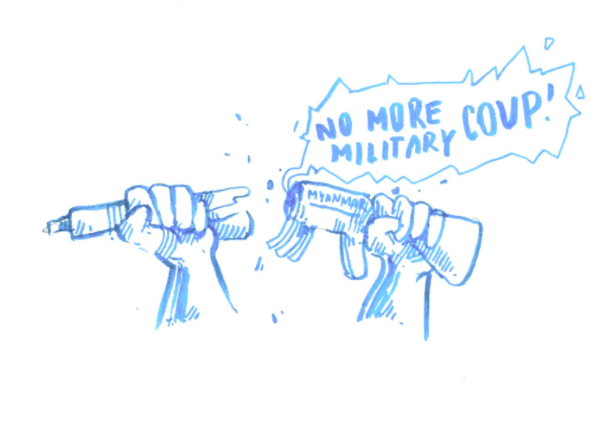The Mynamar Coup Explained
April 26, 2021
On February 1, Myanmar’s military launched a successful coup against the government, imprisoning numerous officials, including Head of State Aung San Suu Kyi. Since then, military leader Min Aung Hlaing has been serving as the head of state. Resultantly, Myanmar citizens have risen in an ongoing series of charged protests against the military rule, which has violently retaliated by brutally cracking down and shutting off public internet access. As of April 12, the death toll of protestors has surpassed 700, including over 40 children.
After nearly a century of British colonization, the Southeast Asian nation of Myanmar, formerly Burma, declared independence in 1948. However, tensions between several ethnic groups hampered efforts to create a solidified state. As a result, the Burmese military launched a coup d’etat and implemented a one-party junta state that remained in power for nearly two decades. Burmese citizens soon became unhappy with the regime’s harsh tactics. In the 1980s, pro-democracy political revolutionary Aung San Suu Kyi became an icon of the movement, which garnered mass support throughout Burma. As a leader for the National League for Democracy political party (NLD), she was constantly censured and berated by members of the incumbent Burmese Socialist Programme Party (BSPP) party. Despite a 1988 election in which the NLD had emerged victorious and captured the majority of parliament, the BSPP military regime refused to concede power.
Suu Kyi was detained and imprisoned on multiple occasions from the late 1980s to 2010. In the 2000s, figures ranging from the leaders of neighboring states (excluding communist Vietnam) to Barack Obama advocated for her freedom. After her release in 2010, she soon became involved again with political activities, eventually winning 2015’s general election and taking office as the head of state (although the de-facto president, certain constitutional eligibility guidelines from the previous government rendered Suu Kyi not eligible for the title). The NLD also swept parliamentary elections.
Although the NLD had a majority of parliamentary seats and the presidency, legal loopholes allowed the military to maintain a tight group on the country’s politics. After the 2020 general election, which resulted in a similar outcome to 2015, top military officials claimed the election to be fraudulent and illegitimate.
Certain members of the PDS community seemed to agree that the coup was the result of the BSPP’s political interests rather than for the nation’s benefit. According to Freshman Riley Schmidt, “This is another example of totalitarian socialist regimes, which have been shown not to work in history, displaying their true colors as they fight to hold onto any relevance they might have, ignoring the interests of the people.”
A member of the Princeton Day Model United Nations team agreed: “The situation in Myanmar is certainly fragile, and I think that the international community must tread carefully in their response. This socialist regime has shown us the death and turmoil it can perpetuate against its own people.”
Sources
- “Myanmar’s Ruling Junta Issues Fresh Charges for Suu Kyi.” AP NEWS, 12 Apr. 2021, apnews.com/article/race-and-ethnicity-aung-san-suu-kyi-myanmar-coronavirus-pandemic-yangon-60297675edf3f1978ff33654205529ce. Accessed 22 Apr. 2021.
- “Myanmar Profile – Timeline.” BBC News, 3 Sept. 2018, www.bbc.com/news/world-asia-pacific-12992883.

















